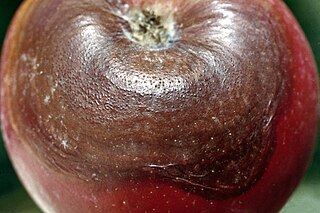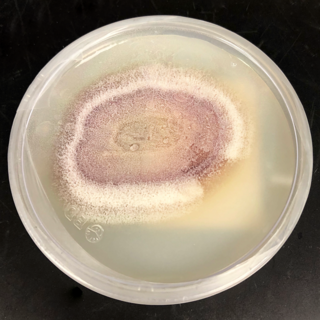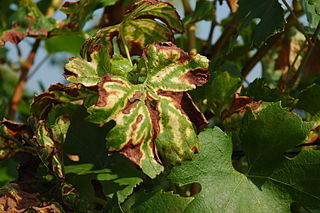Related Research Articles

Diplodia tip blight, also known as Sphaeropsis blight, is a widespread disease affecting conifers caused by an opportunistic fungal pathogen, Diplodia sapinea. It is found in “both hemispheres between the latitudes 30° and 50° north and south". The diseases symptoms include: damping off and collar rot of seedlings, stem canker, root disease, and, most commonly, shoot blight. These symptoms have caused significant economic loss to nurseries and pine plantations. In a nursery in the north-central United States, losses of 35% have been reported. Shoot blight and eventual die back can cause a reduction of marketable volume in timber by 63%. Infection of terminal shoots can result in dead-top which significantly limits the usable length of the tree trunk. The presence of the pathogen in concert with severe weather conditions can lead to extreme loss. Following a severe hailstorm in South Africa, nearly 5,000 acres of pine plantation were infected with Diplodia tip blight. It was necessary to prematurely harvest large swaths of the plantations resulting in a loss of 45%. Areas that were not harvested prematurely still suffered an average timber loss of 11%.

Phomopsis cane and leaf spot occurs wherever grapes are grown. Phomopsis cane and leaf spot is more severe in grape-growing regions characterized by a humid temperate climate through the growing season. Crop losses up to 30% have been reported to be caused by Phomopsis cane and leaf spot.
Eutypa lata is a fungal plant pathogen of grapevines. The fungus also attacks many other hosts such as cherry trees, most other Prunus species, as well as apples, pears and walnuts. In apricots, the fungus reveals a canker surrounding a pruning wound.

Botryosphaeria dothidea is a plant pathogen that causes the formation of cankers on a wide variety of tree and shrub species. It has been reported on several hundred plant hosts and on all continents except Antarctica. B. dothidea was redefined in 2004, and some reports of its host range from prior to that time likely include species that have since been placed in another genus. Even so, B. dothidea has since been identified on a number of woody plants—including grape, mango, olive, eucalyptus, maple, and oak, among others—and is still expected to have a broad geographical distribution. While it is best known as a pathogen, the species has also been identified as an endophyte, existing in association with plant tissues on which disease symptoms were not observed. It can colonize some fruits, in addition to woody tissues.

Botryosphaeria obtusa is a plant pathogen that causes frogeye leaf spot, black rot and cankers on many plant species. On the leaf it is referred to as frogeye leaf spot; this phase typically affects tree and shrubs. In fruit such as the apple, cranberry and quince, it is referred to as black rot, and in twigs and trunks it causes cankers.

Botryosphaeria stevensii is a fungal plant pathogen that causes cankers on several tree species including apple and juniper as well as causing cankers on grape vines. It causes branch dieback, possibly affecting a large portion of the tree canopy, and if severe it can kill entire plants.

Lasiodiplodia theobromae is a plant pathogen with a very wide host range. It causes rotting and dieback in most species it infects. It is a common post harvest fungus disease of citrus known as stem-end rot. It is a cause of bot canker of grapevine. It also infects Biancaea sappan, a species of flowering tree also known as Sappanwood.
Cadophora malorum is a saprophytic plant pathogen that causes side rot in apple and pear and can also cause disease on asparagus and kiwifruit. C. malorum has been found parasitizing shrimp and other fungal species in the extreme environments of the Mid-Atlantic Ridge, and can be categorized as a halophilic psychrotrophic fungus and a marine fungus.

Botryosphaeria ribis is a fungal plant pathogen that infects many trees causing cankers, dieback and death.
The fungal genus Truncatella in the family Sporocadaceae, and in the Amphisphaeriales order, includes plant pathogens such as Truncatella laurocerasi.

Phaeoacremonium is a fungus genus associated with wilt and decline diseases of woody hosts and human infections.
Bot canker of oak is a disease on stems, branches and twigs of oak trees in Europe and North America. The casual agent of Bot canker of oak is the fungus Botryosphaeria corticola. Bot canker of oak causes lesions and cankers on a wide range of oaks in Europe and most recently live oaks in North America. Some infections were formerly attributed to Botryosphaeria stevensii, but most likely represent infections by Botryosphaeria corticola. Botryosphaeria corticola is distinguishable from Botryosphaeria stevensii via ITS rDNA sequencing.

Esca is a grape disease of mature grapevines. It is a type of grapevine trunk disease.
Phaeomoniella is a genus of hyphomycete fungi in the family Celotheliaceae. The genus was circumscribed by Pedro Crous and Walter Gams in 2000 to contain the type species, P. chlamydospora, the causal agent of Petro grapevine decline, a disesase in the esca disease complex. Phaeomoniella is similar to Phaeoacremonium, differing in cultural characteristics, and in the morphology of the conidiophores and conidia.
Phaeomoniella chlamydospora is a fungus species of mitosporic ascomycota in the genus Phaeomoniella.
Diplodia seriata is an anamorphic fungus species in the genus Diplodia. It is a cause of bot canker of grapevine in Mexico.
The black foot disease is a grapevine trunk disease. It is caused by fungi in the genus Cylindrocarpon.
Dothiorella moneti is an endophytic fungus that might be a canker pathogen, specifically for Eucalyptus gomphocephala. It was isolated from said trees in Western Australia.

Neoscytalidium dimidiatum was first described in 1933 as Hendersonula toruloidea from diseased orchard trees in Egypt. Decades later, it was determined to be a causative agent of human dermatomycosis-like infections and foot infections predominantly in tropical areas; however the fungus is considered to be widespread. A newer name, Scytalidium dimidiatum, was applied to a synanamorph of Nattrassia mangiferae, otherwise known as Neofusicoccum mangiferae. Substantial confusion has arisen in the literature on this fungus resulting from the use of multiple different names including Torula dimidiata, Fusicoccum dimidiatum, Scytalidium dimidiatum, and Hendersonula toruloidea. Additionally, Scytalidium lignicola and Scytalidium lignicolum are often considered earlier names of N. dimidiatum.
References
- ↑ "Action FA1303 at European Cooperation in Science and Technology (COST)". Archived from the original on 2014-06-06. Retrieved 2014-06-05.
- ↑ Grapevine Trunk Diseases. symptoms and distribution (link [ permanent dead link ]
- ↑ Botryosphaeria dothidea associated with grapevine trunk disease in south-eastern Australia. Y. Qiu, S. Savocchia, C. C. Steel and G. J. Ash, Australasian Plant Pathology, September 2008, Volume 37, Issue 5, pages 482-485, doi : 10.1071/AP08045
- ↑ Botryosphaeria spp. as grapevine trunk disease pathogens. Niekerk, J.M, P.H. Fourie, F. Halleen and P.W. Crous, Phytopathologia Mediterranea, 2006, volume 45, pages 43-54
- 1 2 Occurrence of grapevine trunk disease pathogens in rootstock mother plants in South Africa. P. H. Fourie and F. Halleen, Australasian Plant Pathology, June 2004, Volume 33, Issue 2, pages 313-315, doi : 10.1071/AP04005
- 1 2 Identification and Pathogenicity of Lasiodiplodia theobromae and Diplodia seriata, the Causal Agents of Bot Canker Disease of Grapevines in Mexico. J. R. Úrbez-Torres, G. M. Leavitt, J. C. Guerrero, J. Guevara and W. D. Gubler, Plant Disease, April 2008, Volume 92, Number 4, pages 519-529, doi : 10.1094/PDIS-92-4-0519
- 1 2 3 4 Mundy, Dion C.; Brown, Albre; Jacobo, Fernanda; Tennakoon, Kulatunga; Woolley, Rebecca H.; Vanga, Bhanupratap; Tyson, Joy; Johnston, Peter; Ridgway, Hayley J.; Bulman, Simon (2020). "Pathogenic fungi isolated in association with grapevine trunk diseases in New Zealand". New Zealand Journal of Crop and Horticultural Science. 48 (2): 84–96. doi:10.1080/01140671.2020.1716813. S2CID 213032421.
- ↑ Travadon, Renaud; Lawrence, Daniel P.; Moyer, Michelle M.; Fujiyoshi, Phillip T.; Baumgartner, Kendra (7 October 2022). "Fungal species associated with grapevine trunk diseases in Washington wine grapes and California table grapes, with novelties in the genera Cadophora, Cytospora, and Sporocadus". Front. Fungal Biol. 3 (Sec. Fungi-Plant Interactions). doi: 10.3389/ffunb.2022.1018140 . PMC 10512239 . PMID 37746176.